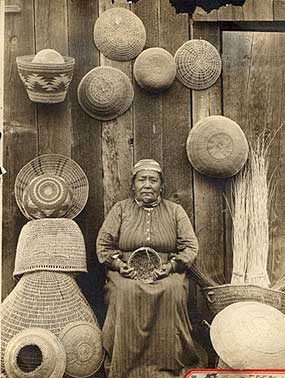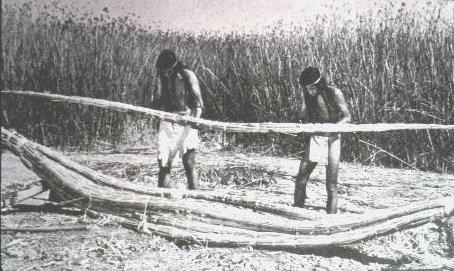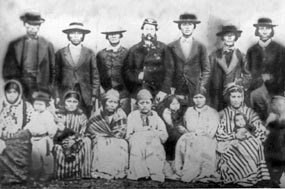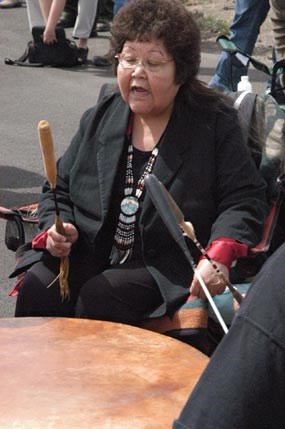
The Modoc people once lived on both sides of what is now the California-Oregon border, in villages on and near Tule, Lower Klamath, and Clear Lakes. Like the ancient people who first inhabited this area more than 11,000 years ago, they took advantage of abundant waterfowl and game, edible and medicinal plants, and an easily accessible water supply. They moved about the region freely with the seasons, until the coming of Euro-Americans in 1826 when the pattern of Modoc life began to change. The Modoc, a fiercely independent people, began to clash with some of the newcomers who laid claim to Modoc land, sowing the seeds for one of the most tragic of the Indian Wars: the Modoc War of 1872-73.
With the coming of summer, the Modoc moved to higher elevations south of the lava beds (on today's Modoc National Forest) where they established mountain camps to hunt and gather nuts and berries. Autumn was a crucial time for the Modoc people when food was prepared and transported down to permanent winter camps on the banks of lakes and rivers. Their earth lodges, as many as twenty in each village, were readied for the severe cold of winter storms. When the band moved into their winter villages, older people repaired broken tools and weaved baskets, while younger members of the village listened to the elders recount the history of the tribe in legend and song. Throughout the year, places of spiritual importance in the lava beds and the highlands were visited by spiritual leaders and young tribal members coming of age. 
Using Plants and Animals The Modoc used many plants in this area for food, medicine, tools, or a combination of all three. The water lily, or “wocas,” provided a staple food when its seeds were ground into meal or flour in rock mortars. Tule reeds found along shorelines provided material for baskets, sleeping mats, and sandals, among many other uses. The Modoc used sagebrush bark to make baskets, clothing and footwear. Women were responsible for much of the plant gathering and food preparation. The Modoc made intricate hunting and fishing implements from local materials. They fashioned boats and rafts for transportation and fishing from tule reeds, and hollowed out sturdier dugout canoes with fire and scraping. Nets of woven tule fibers weighted with lava rocks could be used to catch seasonal runs of fish. Waterfowl were also caught in nets as they flew low over ridgelines. Bows were constructed from juniper limbs with deer sinew bowstrings. Arrow shafts were constructed from tule reeds, while the arrowheads were razor-sharp pieces of obsidian gathered from the highlands and worked with deer antler tools. Birds, fish, and game were hunted with either obsidian-tipped arrows or spears. Modoc men hunted mule deer, pronghorn antelope, bighorn sheep, and many types of waterfowl. The hunt was an important part of a Modoc man’s life, and preparation for the hunt usually involved time in a sweat lodge. 
Modern Modoc Peoples The Modoc Tribe of Oklahoma The Modoc War of 1872-73 had a devastating impact on the Modoc people. After the war ended, 155 Modoc who had fought alongside Captain Jack in the lava beds were transported as prisoners over 2000 miles by rail to the Quapaw Reservation in Oklahoma. For these Modoc, this marked the beginning of a desperate struggle for survival in the history of their people. Where were the grasses and reeds they needed to make their fine baskets? Where were the lakes, teeming with millions of waterfowl, and the winter herds? What of the spirits of their ancestors left behind? Disease soon spread through the tribe in Oklahoma, as they lacked resistance to new illnesses. As the Modoc tried to adapt to planting strange crops, they were weakened by malaria. Thirty-three died in a single year. By the turn of the century twenty-seven years later, there were fewer than 50 Modoc on the rolls of the Quapaw Agency. Even so, the Modoc demonstrated their historic tenacity by working hard to make their land productive and to increase their herds of livestock. The Modoc further supplemented their meager government rations by working for Euro-Americans in the border settlements, and by making and selling the arts and crafts of other tribes. The Modoc Tribe of Oklahoma today is composed of descendants of only seven of the original 155 prisoners of war. The Modoc are now part of an eight-tribe council made up of native peoples from all parts of the country. More than a century after their exile, the Modoc of Oklahoma have continued to adapt to life in a new land, raising cattle and establishing businesses with their neighbors. Their history is one of adaptation and persistence—both an end and a beginning for a people and a way of life. 
The Klamath Tribes During the Modoc War, many Modoc never became involved in the conflict.They were not exiled to Oklahoma like the followers of Captain Jack. They were, however, forced to remain on the Klamath Reservation, the homeland of their Klamath neighbors instead of their own land. Though the climate and resources were similar to which they were accustomed, there were daily reminders that they were not home. They dealt in close quarters with Indian Agents as well as Klamath and Yahooskin tribal members. Like all Native Americans in the nineteenth century, they were forbidden to practice their traditional religion or speak their language. All three tribes came to be recognized by the federal government as the Klamath Tribes, and engaged in many profitable ventures in the twentieth century including ranching, freighting, and the timber industry. In 1954, however, the Klamath Tribes were terminated from federal recognition. After a legal struggle spanning decades, they were successful in regaining status as a federally-recognized tribe in 1986. A restoration Celebration is held every August in Chiloquin, Oregon to mark the event. You can learn more here: The Klamath Tribes website

Lava Beds Homeland Lava Beds National Monument is in the traditional homeland of Captain Jack's southern Modoc band. Places where the ancestors of modern Modoc people lived, gathered plants, conducted spiritual activities, and made their stand during the Modoc War remain, protected by the National Park Service. Today tribal members participate in both private activities and public education efforts at Lava Beds to ensure these connections to the landscape endure. |
Last updated: February 2, 2024
